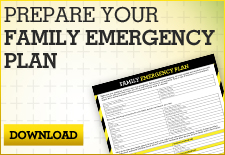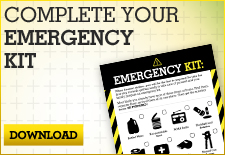
Disasters can happen… at any time. Be prepared to take action before, during and after.
Floods
Floods are one of the most common hazards in the U.S. For Illinois, Indiana, and Wisconsin, floods impact the State annually and are likely to occur in many jurisdictions. For example, since 1981, 99 of the 102 counties in Illinois have been declared major disaster areas by the President due to flooding.
Not all floods are alike. Some floods develop slowly – often times over a period of days. Flash floods can develop quickly, sometimes in a matter of minutes and without any visible signs of rain. Flash floods often have a dangerous wall of roaring water that carries rocks, mud and other debris, sweeping away most things in its path. Here are terms that may be used by local officials to describe flooding in your community:
Before
Before an event, information about the risk of floods can be found on local television and radio, the National Weather Service, and the National Oceanic and Atmospheric Administration. To find out about any potential flooding in your area, visit www.weather.gov and input your zip code.
2 – Complete the Emergency Contacts Card and place one in every Go Kit.
3 – Prepare a Go Kit for every family member. The Go Kit should be easily accessible if you have to leave your home in a hurry, and each household member’s Go Kit should be packed in a sturdy, easy-to-carry container such as a backpack. Make sure it is ready to go at all times of the year and contains items suitable for the season. Click for Go Kit items.
- If you are not evacuating, plan for moving essential items to an upper floor and sticking to higher ground.
- If you are advised to evacuate, do so immediately. Evacuation is simple and safer before the flood waters rise. Don’t forget the Go Kit of each family member, these should include the Emergency Contacts Card, and your Family Emergency Plan which includes your evacuation location options.
- Have your evacuation plan, and follow recommended routes.
- Do not walk through moving water, it is deceptively strong.
- If you have to walk through water, choose a route with still water.
- Use a stick to check the firmness of the ground in front of you.
- Do not drive into flooded areas because you and the vehicle can be quickly swept away.
- Do not drive into flooded areas.
- If floodwaters rise around your car, abandon it. Move to higher ground safely.
- Know that 6 inches of water will reach the bottom of most passenger cars causing loss of control and possible stalling.
- Be aware that most vehicles begin to float in just 12 inches of water. 24 inches of water will sweep most vehicles away, including SUVs and pick-ups.
- Find out if you live in a flood-prone area by visiting www.floodsmart.gov.
- Know if your property is above or below the flood stage water level and learn about the history of flooding for your region.
- Ask your insurance agent about flood insurance. Most homeowner and renter policies do not cover flood damage, but can be accessed through the National Flood Insurance Program (NFIP).
- Have check valves installed in building sewer traps to prevent flood waters from backing up in sewer drains
- Seal walls in basements with waterproofing compounds to avoid seepage.
- Raise items in basements or at ground level to upper floors or higher off the ground to prevent damage if floodwater enters your home.
During
During a flood it is important to be aware and knowledgeable on what’s happening. Listen to news reports, secure important items to higher ground and get ready to make the decision to stay or go. The following are tips to help you:
After
Many injuries take place after a flood happens. Flood waters, standing water and flood water residue pose various risks including injuries, infectious diseases and chemical hazards. These tips will help to keep you and your family safe from the aftermath of a flood:
- Service damaged septic tanks, cesspools, pits, and leaching systems as soon as possible. Damaged sewage systems are serious health hazards.
- Clean and disinfect everything that got wet. Mud left from floodwater can contain sewage and chemicals. You can use a solution of 1 cup of bleach to 5 gallons of water to disinfect surfaces, especially those that may come into contact with food or areas where small children play.
- Look out for any mold growth after a flood and learn about the best way to address any issues that you see.



